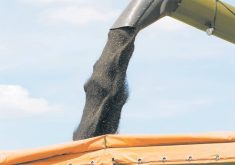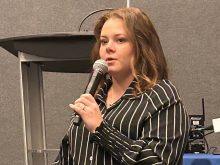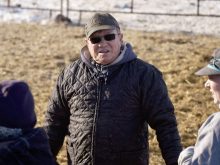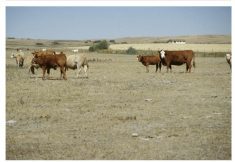Hammered by dry weather and trade upheaval, many Alberta producers are struggling with cash flow. And more will be in the months ahead.
But there is help out there.

“It’s important for producers to know that there are more options out there than they may realize,” said Don Anderson, Farm Credit Canada’s senior vice-president of Alberta operations.
Some farm lenders, including FCC, are offering to ease the financial burden either through “injecting additional capital,” deferring some repayments, or a combination of both.
“That gives producers space so that they can make the decisions that are best for the operation under a little less stress,” he said. “One year shouldn’t make or break an operation.”
But this year is certainly putting many to the test.
“If you get to the southeastern part of the province, they’re struggling,” said Anderson. “They’ve had a little bit of rain, but where they desperately need the extra bit of rain, it hasn’t got there.
Read Also

Grazing ‘sweet spot’ boosts pasture performance
Timing-focused approach to pasture management touted to boost forage growth, livestock gains while also cutting farmer labour and inputs
“Crops are definitely impacted, and if they’re getting a crop, it’s a subpar crop.”
The livestock sector has been hit even harder, he added.
“As we go southeast, a large part of our beef herd is located in these areas, and the pastures and forage are a real challenge there right now.”
On top of that is the China situation. First it barred imports of Canadian canola seed, and then meat.
“There are ongoing trade issues and tensions with a significant trading partner of ours in China, and that’s impacting both the livestock and the grains and oilseeds sectors, primarily canola,” said Anderson.
“That’s putting some strain on producers from a cash flow perspective. There are a lot of unknowns happening there.”
The debt dilemma
And while lenders can’t do anything about the weather or trade disputes, they can — and want to — help producers get through this period in the best possible shape, said Anderson.
As an example, he pointed to a livestock producer concerned about not having enough cash to feed through the winter.
“What’s their first response? Liquidate the herd. But that has a long-term impact,” said Anderson. “They’ve probably built that herd over time. They can buy it back eventually, but they can’t buy back exactly the same things.”
It’s a similar story on the crop side.
When producers have limited working capital, they may not be able to buy inputs at the optimal time, when costs are cheaper. Higher operating costs are the last thing a farmer needs when prices are going down.
“So can we come in and support them through different strategies so that they have that cash and that liquidity to get through to the next growing season until they can get a reset and start again?” said Anderson.
“At the end of the day, you may have more debt, but ultimately, it’s a choice: Do you want to have a stronger, more viable operation going into the future, or are you going to leave yourself a bit more exposed and in a weaker position to move forward?”
Cash advances
But loan deferrals and more financing are only two pieces of the puzzle that farmers must deal with, he added.
“This needs to be coupled with other options that are out in the marketplace, like interest-free periods for the canola cash advance that the federal government had announced,” said Anderson.
“That’s a short-term fix, and what we’re trying to do is look at our options — in conjunction with those short-term fixes — to get people over this hump.”
There are three dozen administrators of the federal Advance Payment Program, which allows producers to borrow up to $1 million every year based on the value of their grain or livestock, with the first $100,000 of that as an interest-free advance ($400,000 for canola). One of those administrators is Alberta Wheat, which launched its FarmCash program last year.

“The FarmCash program is another option for farmers to maintain their cash flow in a difficult market,” said Tom Steve, the farm group’s general manager.
“Really, it’s designed to assist farmers with managing their cash flow — reducing the cost of inputs in the spring and offering the ability to finance against inventories that they have on hand so that they don’t have to sell their crop or their livestock below the cost of production.”
Although part of the advance is interest free and the remainder “considerably below commercial credit rates,” the loan ultimately will need to be repaid — 18 months for crops and 24 months for livestock.
So producers need to be both mindful of the increased debt load they’re taking on and other program options available to them.
“We’re in a period where there are significant trade challenges and weather challenges in many areas, and we look at the FarmCash program as one tool that farmers can employ to manage their risk and get through some difficult circumstances,” said Steve.
“But it needs to be taken into consideration with the other risk management offerings that they have at their disposal.”
Government programs
In Alberta, those include federal crop insurance and disaster recovery programs administered by the Agriculture Financial Services Corporation.
“Every year, we have something new and different that comes up, but weather is one of those challenges that impacts agriculture every year,” said Daniel Graham, manager of business risk management products at AFSC.
“AFSC has a suite of business risk management programs that are available to producers to help mitigate some of the unique risks in agriculture.”
Two of them have been designed to provide a “backstop” to producers during disasters and other events that impact production or prices, he said.
AgriInsurance covers losses caused by designated natural perils for crops, hay and pasture, while AgriStability compensates participating producers against significant declines in farm incomes.
Both require producers to sign up by April 30 — although the deadline for AgriStability was extended to July 2 this year in response to the trade dispute with China.
“We’ve had an uptick in participation with that deadline extension,” said Graham.
For producers who didn’t sign up this year, now is “a good time” to start thinking about getting this protection for next year, he said.
“The best place to start is contacting your local AFSC office to have a discussion about what those business risk management programs are and how they can work for your operation.”
Farmers should do the same with their lender and financial advisers, added FCC’s Anderson.
“Before you make any significant decisions that will have long-term impacts on your operation, go in and talk to your financial services provider and ensure that you have all the information about what options are available to you.”
And while everyone hopes that the trade situation with China will be resolved and that the weather will be more favourable, producers need to understand all of these tools and the advantages they provide, the three experts said.
“Ultimately, farming and ranching are fairly low-margin businesses, so you need to be able to capture an advantage wherever you can,” said Steve.
“These programs are designed to assist farmers, and they should take full advantage of them.”















